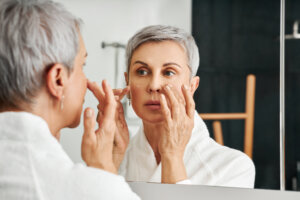Read Full Article HereYour Skin Can Reveal Some Surprising Things About Your Health
Your skin is the largest of the dozens of organs that make up the human body, covering the entire outside of the body. At 2 millimeters thick and weighing about 6 pounds, human skin acts as as a protective barrier against everything outside the body, including light, heat, disease, and injury. In addition, the skin serves as a thermostat, gathering data from the environment to regulate body temperature. It also provides a means through which the body can receive hydration and nutrients.
The skin is one of the body’s most vital organs (meaning it is necessary to sustain life). The appearance of your skin offers every person with a wide range of clues as to their age, health, and general well-being. But to a medical professional, a good look at your skin can be a first step in diagnosing a number of conditions and illnesses, according to plastic surgeon Andrew Ordon. Here are some of the surprising things your skin can reveal about your health.
Velvety thickening in the armpits and neck can be a sign of this condition
The condition known as “acanthosis nigricans” causes velvety, light-brown or black markings to appear on the neck, armpits, and sometimes the groin. According to dermatologist Tsippora Shainhouse, this can be a sign of type 2 diabetes. With type 2 diabetes, the body is unable to properly process the hormone, insulin, which is needed to metabolize glucose for use in cells and tissues. The body responds to the challenge by dumping excess insulin into the blood in an attempt to grab onto the glucose, Dr. Shainhouse told Health Digest. The extra insulin finds its way into skin cells, resulting in the darkened, thickened patches.
Acanthosis nigricans is most commonly associated with diabetes; in fact, it is one of the 10–15 skin complications associated with the condition, dermatologist Ricardo Castrellon told Health Digest. Diabetes isn’t the only cause, though; acanthosis nigricans may be seen when using certain medications such as systemic glucocorticoids and birth control pills. But since it is also, on rare occasions, a sign of an internal malignancy, and type 2 diabetes carries significant stakes, it’s worth checking with your doctor if you notice these changes on your skin.
Chin and jawline acne could point to PCOS
Polycystic ovary syndrome (PCOS) is a fairly common health condition among women of childbearing age. It’s caused by a hormonal imbalance that results in elevated androgen (relative to estrogen) levels in the body. The imbalance can lead to the development of multiple benign cysts on the ovaries, irregular periods, and infertility. The elevated androgen levels inherent in PCOS can cause changes in a woman’s appearance as well, dermatologist Tsippora Shainhouse told Health Digest. These changes can include weight gain, thinning hair, the development of male-pattern facial hair, as well as chin and jawline acne.
Up to 10 percent of all women of childbearing age have PCOS, but many don’t realize it until they experience difficulty becoming pregnant. If you have irregular periods and notice chin and jawline acne and/or facial hair growth, it may be worth consulting your doctor. PCOS can be managed with hormones and diet, and many women can reverse the symptoms.
These bumps on your skin may be a sign of gluten sensitivity
Dermatitis herpetiformis, which is sometimes referred to as DH or Duhring’s disease, is a chronic skin condition characterized by extremely itchy bumps and small blisters often on the elbows, knees, scalp, and buttocks. The vast majority of DH cases occur in conjunction with a sensitivity to gluten, according to dermatologist Hadley King.
That sensitivity may or may not be diagnosable as celiac disease, an autoimmune disease in which ingestion of gluten damages the small intestine, Dr. King explained to Health Digest. While people with DH may experience many of the same complications suffered by people with celiac disease, as many as 20 percent of people with DH will test negative for celiac, according to the Celiac Disease Foundation.
It is worth noting that although the name might seem to imply the involvement of the herpes virus, that is not the case. The condition is so named because the bumps and blisters look like herpes lesions. However, herpes lesions do not typically present in clusters the way DH does, and DH is not caused by any virus, let alone the herpes virus. In addition, DH is sometimes mistaken for eczema. A DH diagnosis can only be made by a doctor, and symptoms normally resolve with a strict, gluten-free diet.
Dry skin and loss of eyebrows could mean a thyroid condition
While a diagnosis of a thyroid condition cannot be made just by looking at the skin, certain skin changes may suggest it’s worth having your thyroid levels checked out by a doctor. One is dry skin, which, according to dermatologist Joshua Ziechner can indicate low thyroid function. “We know that low thyroid function affects skin cell function, including its ability to protect itself from the environment and maintain hydration,” Dr. Zeichner told Health Digest.
Another is a eyebrow loss or thinning that can’t be blamed on overplucking, dermatologist Tsippora Shainhouse explained to Health Digest. Like dry skin, eyebrow loss/thinning, which is known clinically as madarosis, can be a sign of an under-active thyroid. When this is the case, madarosis may be accompanied by cold intolerance, loss or thinning of scalp hair, weight gain, fatigue, and depression. “Thyroid hormones boost our metabolism and energy, so low levels can impact both how we feel and look,” Dr. Shainhouse noted. But the condition is treatable, usually via prescription thyroid hormone replacement.
Easy bruising could signify a blood disorder
Bleeding, whether externally or internally (aka bruising) after an injury is perfectly normal. However, if you’ve been bleeding or bruising with no obvious explanation, it is possible that it could indicate a blood disorder, according to dermatologist Joshua Ziechner. People with the blood-clotting disorder, hemophilia, may bleed excessively after a seemingly small injury. Platelet disorders can also result in excessive bleeding and bruising. Additionally, certain blood cancers can be responsible for excessive bruising and poor wound healing, Dr. Zeichner told Health Digest.
Hemophilia, platelet disorders, and blood cancers are rare, however. Other symptoms that would suggest someone may have a blood disorder include frequent, unexplained nosebleeds, excessive or prolonged periods, excessive bleeding while brushing teeth or flossing, and red or purple dots or patches on the skin. Other causes of excessive bleeding and bruising can include deficiencies in certain vitamins, including vitamin C and vitamin K.
Yellow bumps on the eyelids can indicate that you have high cholesterol
A surprising thing your skin can reveal about your health is your cholesterol level. Yes, thick, yellow/orange bumps known as xanthomas can be a sign that you have too much cholesterol circulating in your blood, dermatologist Rhonda Klein told Health Digest. When these bumps appear on the eyelids, they are known as xanthelasmas. They are actually made of cholesterol deposits under the skin, according to Dr. Klein.
Xanthomas can be very small or as large as three inches. Thankfully, though, they “may go away on their own” once you treat the underlying problem, according to Beth Israel Lahey Health. Although cholesterol is often the culprit, other health conditions that may cause these bumps can be just as, if not more, worrisome than high cholesterol. These include low thyroid function (hypothyroidism), cirrhosis of the liver, diabetes, and certain cancers. If you notice these bumps, you’ll want to schedule an appointment with your doctor to determine the cause.
A butterfly rash on the face could signify lupus
Lupus erythematosu, more commonly known just as lupus, is an autoimmune disease that can present with a rash on the face in the shape of what some describe as a butterfly, dermatologist Tsippora Shainhouse told Health Digest. It has also been likened to a half-mask. Either way, it is known clinically as a malar rash. While the malar rash is most often associated with lupus, it can also be associated cellulitis, which is an infection of deep within the skin and potentially involving subcutaneous fat. A less serious condition with which the malar rash is associated is rosacea. Rosacea is a common skin condition that causes redness and visible blood vessels in your face.
Lupus, however, causes inflammation in tissues and organs, including not only the skin but also the muscles, joints, kidneys, lung, and heart, according to dermatologist Rhonda Klein. It tends to occur with a number of other symptoms, including sun sensitivity, joint pain, and neurological or psychological changes. The only way to know for sure what is causing the butterfly-shaped rash is to see a doctor.
New changes in breast skin can be a sign of a rare type of breast cancer
Inflammatory breast cancer (IBC) is an unusual form of breast cancer, accounting for only 1 to 5 percent of all breast cancer cases, according to the American Cancer Society. Though rare, the society revealed that it “tends to occur in younger women (younger than 40 years of age),” and “African-American women appear to develop IBC more often than white women.”
Inflammatory breast cancer differs from other forms of breast cancer in a number of ways, including the fact that rarely does it present as a lump. More often, dermatologist Tsippora Shainhouse told Health Digest, inflammatory breast cancer presents with breast swelling, purple or red discoloration of the breast skin, and/or a thickened/puckered orange peel-like texture to the breast. Some clinicians refer to this symptom as “peau d’orange,” which translates from French to mean “orange skin.”
Other symptoms may include a newly inverted nipple, nipple discharge, or a new and persistent lump that does not change size over the course of a menstrual cycle. Not all breast skin changes lead to a diagnosis of inflammatory breast cancer, but if you have any of the symptoms Dr. Shainhouse identified, it would be worth a consult with your doctor.
Yellowing skin can be a symptom of liver disease
“Changes in our skin are indicators of our general health as well as signs of underlying disease,” plastic surgeon Andrew Ordon told Health Digest, which is why it is important to pay attention to those changes. Many will turn out to mean nothing, but some can be serious. One of the more serious skin changes seen in the medical world is a yellowing of the skin. Clinically, this is referred to as “jaundice,” and it can be seen not only on the skin but in the whites of the eyes and the mucous membranes.
Jaundice is caused by a high level of bilirubin, a yellow-orange bile pigment secreted by the liver. It is often associated with underlying disease, especially of the liver (including hepatitis, cirrhosis, and cancer), according to Dr. Ordon. Jaundice is also associated with pancreatic cancer and gallbladder cancer, but it can be a symptom of less serious conditions, like gallstones. In addition, jaundice can appear after taking certain medications, including penicillin.
Freckles and sun spots can reveal sun damage
Freckles can look adorable, but they can also reflect damage to the skin done by exposure to the sun. “Freckles and dark spots are a measure of your lifelong sun damage,” dermatologist Ricardo Castrellon confirmed in an interview with Health Digest.
Most of the sun damage we see reflected on our skin occurred during the childhood and teen years, and that damage can set the scene for later in life. Continued sun exposure only increases your lifetime risk for skin cancer. There are a number of different forms of skin cancer, including melanoma, which is the most serious form in that it can spread to other organs. Not all skin cancers are life-threatening, but some can prove disfiguring. Early detection is therefore very important, according to Dr. Castellon, who recommends that we all regularly check our skin for changes.
That said, changes do not necessarily indicate skin cancer, but your dermatologist may remove skin that has changed both to biopsy it and to for the purpose of preventing it from changing further into cancer.
Swollen, painful sores on your feet and hands can be a sign of this disease
If you’re on the lookout for symptoms of COVID-19, you’re likely watching for a dry cough, fever, and shortness of breath, but you also might want to have a look at your skin, according to the American Academy of Dermatology. “While less common, the coronavirus can affect your skin. For some people, this may be the only sign of a coronavirus infection,” the academy revealed.
When COVID-19 effects the skin, it tends to involve discolored and swollen toes. According to dermatologist Rhonda Klein, these have been termed “COVID toes” and can involve swollen, painful sores that resemble frostbite, particularly around the toenails. However, the condition has also presented in some patients on the hands, fingers and fingernails. Wondering what you should do if you think you have “COVID toes”? Since the virus is a public health problem, it is imperative to seek out testing and quarantine yourself until you know for sure that you are not carrying the virus.
An itch that won’t go away can reveal an underlying blood disorder
In a large survey involving over 300 people who had been diagnosed with cutaneous T-cell lymphoma (CTCL), a form of cancer that begins in white blood cells and goes on to attack the skin, a significant majority (88 percent) reported experiencing bothersome itching. Clinically, persistent itchiness is referred to as “pruritus.” Pruritus is most commonly associated with disorders of the skin, including psoriasis and eczema. “However, when a primary skin condition cannot be identified as the cause of pruritus, then a systemic cause must be sought,” according to Medscape.
“There are many reasons for pruritus,” dermatologist Jennifer Gordon told Health Digest, and not all are life-threatening. But some, like CTCL and polycythemia vera, a rare blood disorder, can be. Additionally, diffuse itching can be caused by kidney or other organ failure. If the itch is right in the middle of your back, it could indicate notalgia parasthetica, which is thought to be caused by nerve inflammation.
The Mayo Clinic recommends scheduling an appointment with your doctor if the itching persists for longer than two weeks and doesn’t seem to improve, severe enough to be distracting, or present with other symptoms like fatigue or fever. If this itching continues for three months even with treatment, the clinic advises seeing a dermatologist.
Brown spots on fingers or toes can reveal a heart infection
If you see brownish spots on your fingers or toes, especially if you’re also feeling feverish, could be a sign of endocarditis, the clinical term for an infection of the heart valve and the inner lining of the heart chamber (also know as the endocardium), physician Leann Poston told Health Digest. Endocarditis happens when bacteria or fungi enter the bloodstream and settle in the heart. It’s a rare condition in people with normal functioning hearts and no specific risk factors. It’s more common in people who have an artificial heart valve or have had a previous case of endocarditis.
The spots that Dr. Poston is talking about, which are sometimes referred to as “Janeway lesions” are painless, but they definitely shouldn’t be ignored because they are often associated with more serious and complicated cases of endocarditis. This can involve septic emboli, which means the bacteria causing the illness have formed deposits in the blood vessels.
Rapid development of stretch marks could reveal Cushing’s syndrome
Cushing’s syndrome is condition in which your body makes too much of the hormone, cortisol. Cushing’s is rare, but when it occurs, it is usually caused by a benign tumor on the pituitary gland, although Cushing’s can also develop after years of using steroidal medications. Steroids contain a synthetic form of the hormone cortisol, which is often referred to as the “stress hormone” because it supports the body’s response to stress by, among other things, reminding us to eat energy-dense foods.
Although the most prominent symptom of Cushing’s syndrome is weight gain, particularly around the midsection and upper back, it can also present with rapid development of multiple pink and/or purple stretch marks on the arms, abdomen, and shoulders that can’t be explained by pregnancy or, in the case of a child, a growth spurt, dermatologist Sharleen St. Surin-Lord told Health Digest.
Other ways that Cushing’s reveals itself through the skin is through thinning, fragile skin, slow healing of minor wounds, and acne. “Your skin is speaking to you, Dr. St. Surin-Lord made a point of reminding Health Digest. “If it’s telling you something is off, it’s wise to listen.”
Your Skin Can Reveal Some Surprising Things About Your Health
January 25, 2023








